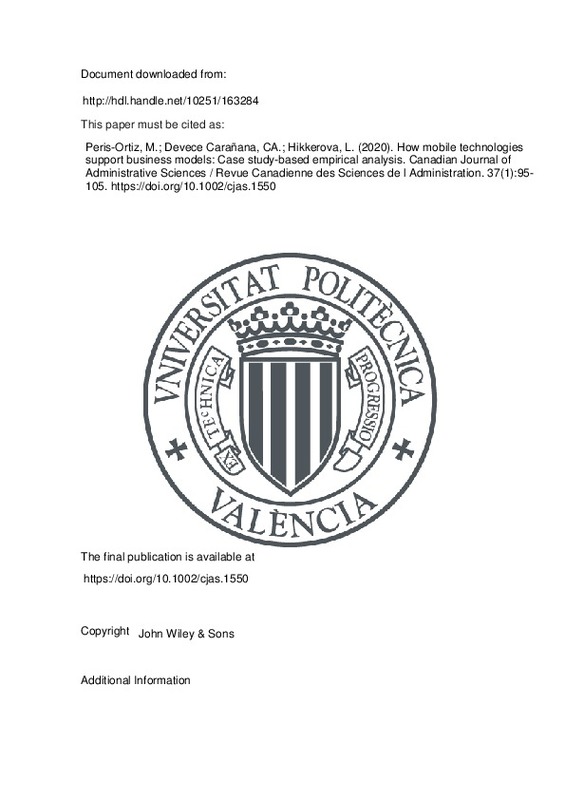Al-Debei, M. M., & Avison, D. (2010). Developing a unified framework of the business model concept. European Journal of Information Systems, 19(3), 359-376. doi:10.1057/ejis.2010.21
Arlotto, J., Sahut, J.-M., & Teulon, F. (2011). Le concept de Business Model au travers de la littérature. Gestion 2000, 28(4), 33. doi:10.3917/g2000.284.0033
Clemons, E. K. (2009). Business Models for Monetizing Internet Applications and Web Sites: Experience, Theory, and Predictions. Journal of Management Information Systems, 26(2), 15-41. doi:10.2753/mis0742-1222260202
[+]
Al-Debei, M. M., & Avison, D. (2010). Developing a unified framework of the business model concept. European Journal of Information Systems, 19(3), 359-376. doi:10.1057/ejis.2010.21
Arlotto, J., Sahut, J.-M., & Teulon, F. (2011). Le concept de Business Model au travers de la littérature. Gestion 2000, 28(4), 33. doi:10.3917/g2000.284.0033
Clemons, E. K. (2009). Business Models for Monetizing Internet Applications and Web Sites: Experience, Theory, and Predictions. Journal of Management Information Systems, 26(2), 15-41. doi:10.2753/mis0742-1222260202
Comberg, C., & Velamuri, V. K. (2017). The introduction of a competing business model: the case of eBay. International Journal of Technology Management, 73(1/2/3), 39. doi:10.1504/ijtm.2017.082356
Coursaris C. Hassanein H. &Head M. (2006).Mobile technologies and the value chain: Participants activities and value creation(p. 8) sInternational Conference on Mobile Business Copenhagen Denmark.
Ehrenhard, M., Wijnhoven, F., van den Broek, T., & Zinck Stagno, M. (2017). Unlocking how start-ups create business value with mobile applications: Development of an App-enabled Business Innovation Cycle. Technological Forecasting and Social Change, 115, 26-36. doi:10.1016/j.techfore.2016.09.011
European Parliament(2015).The Internet of things: Opportunities and challenges. Retrieved fromwww.europarl.europa.eu/RegData/etudes/BRIE/2015/557012/EPRS_BRI(2015)557012_EN.pdf
Gurrin, C., Smeaton, A. F., & Doherty, A. R. (2014). LifeLogging: Personal Big Data. Foundations and Trends® in Information Retrieval, 8(1), 1-125. doi:10.1561/1500000033
Hübner, A. H., Kuhn, H., & Wollenburg, J. (2016). Last mile fulfilment and distribution in omni-channel grocery retailing: a strategic planning framework. International Journal of Retail & Distribution Management, 44(3). doi:10.1108/ijrdm-11-2014-0154
Kauffman, R. J., & Wang, B. (2008). Tuning into the digital channel: evaluating business model characteristics for Internet firm survival. Information Technology and Management, 9(3), 215-232. doi:10.1007/s10799-008-0040-3
Liang, T., Huang, C., Yeh, Y., & Lin, B. (2007). Adoption of mobile technology in business: a fit‐viability model. Industrial Management & Data Systems, 107(8), 1154-1169. doi:10.1108/02635570710822796
Martinez-Simarro, D., Devece, C., & Llopis-Albert, C. (2015). How information systems strategy moderates the relationship between business strategy and performance. Journal of Business Research, 68(7), 1592-1594. doi:10.1016/j.jbusres.2015.01.057
Mello P.A.(2012).A critical review of applications in QCA and fuzzy‐set analysis and a ‘toolbox' of proven solutions to frequently encountered problems APSA Annual Meeting Paper. Retrieved fromhttps://ssrn.com/abstract=2105539
Melville, Kraemer, & Gurbaxani. (2004). Review: Information Technology and Organizational Performance: An Integrative Model of IT Business Value. MIS Quarterly, 28(2), 283. doi:10.2307/25148636
Ngai, E. W. T., & Gunasekaran, A. (2007). Mobile commerce: Strategies, technologies, and applications. Decision Support Systems, 43(1), 1-2. doi:10.1016/j.dss.2005.05.002
Palattella, M. R., Dohler, M., Grieco, A., Rizzo, G., Torsner, J., Engel, T., & Ladid, L. (2016). Internet of Things in the 5G Era: Enablers, Architecture, and Business Models. IEEE Journal on Selected Areas in Communications, 34(3), 510-527. doi:10.1109/jsac.2016.2525418
Pateli, A. G., & Giaglis, G. M. (2005). Technology innovation‐induced business model change: a contingency approach. Journal of Organizational Change Management, 18(2), 167-183. doi:10.1108/09534810510589589
Piccoli, & Ives. (2005). Review: IT-Dependent Strategic Initiatives and Sustained Competitive Advantage: A Review and Synthesis of the Literature. MIS Quarterly, 29(4), 747. doi:10.2307/25148708
Porter M. E.(2001).Strategy and the Internet. Harvard Business Review March 63–78.
Ragin C. C.(2008).User's Guide to Fuzzy‐Set/Qualitative Comparative Analysis. Working Paper University of Arizona Arizona.
Ray, G., Barney, J. B., & Muhanna, W. A. (2003). Capabilities, business processes, and competitive advantage: choosing the dependent variable in empirical tests of the resource-based view. Strategic Management Journal, 25(1), 23-37. doi:10.1002/smj.366
Richter, C., Kraus, S., & Syrjä, P. (2015). The shareconomy as a precursor for digital entrepreneurship business models. International Journal of Entrepreneurship and Small Business, 25(1), 18. doi:10.1504/ijesb.2015.068773
Schneider, M. R., Schulze-Bentrop, C., & Paunescu, M. (2009). Mapping the institutional capital of high-tech firms: A fuzzy-set analysis of capitalist variety and export performance. Journal of International Business Studies, 41(2), 246-266. doi:10.1057/jibs.2009.36
Sheng, H., Nah, F. F.-H., & Siau, K. (2005). Strategic implications of mobile technology: A case study using Value-Focused Thinking. The Journal of Strategic Information Systems, 14(3), 269-290. doi:10.1016/j.jsis.2005.07.004
Sorescu, A. (2017). Data-Driven Business Model Innovation. Journal of Product Innovation Management, 34(5), 691-696. doi:10.1111/jpim.12398
Tallon, P. P. (2007). A Process-Oriented Perspective on the Alignment of Information Technology and Business Strategy. Journal of Management Information Systems, 24(3), 227-268. doi:10.2753/mis0742-1222240308
Tjaden, G. S. (1996). Measuring the information age business. Technology Analysis & Strategic Management, 8(3), 233-246. doi:10.1080/09537329608524248
Vilmos A. Kovacs K. &Kutor L. (2007).NFC applications and business model of the ecosystem(pp.1469–1473) 16th IST Mobile and Wireless Communications Summit Budapest Hungary. doi:https://doi.org/10.1109/ISTMWC.2007.4299324.
Wirtz, B. W., Schilke, O., & Ullrich, S. (2010). Strategic Development of Business Models. Long Range Planning, 43(2-3), 272-290. doi:10.1016/j.lrp.2010.01.005
Woodbridge R.(2010).9 mobile business models that you can use right now to generate revenue. Tether. Retrieved February 2 2019 fromhttp://untether.tv/2010/8‐mobile‐business‐models‐that‐you‐can‐use‐right‐now‐to‐generate‐revenue/
Woodside, A. G., & Zhang, M. (2011). Identifying X-Consumers Using Causal Recipes: «Whales» and «Jumbo Shrimps» Casino Gamblers. Journal of Gambling Studies, 28(1), 13-26. doi:10.1007/s10899-011-9241-5
Woodside, A. G. (2013). Moving beyond multiple regression analysis to algorithms: Calling for adoption of a paradigm shift from symmetric to asymmetric thinking in data analysis and crafting theory. Journal of Business Research, 66(4), 463-472. doi:10.1016/j.jbusres.2012.12.021
[-]







![[Cerrado]](/themes/UPV/images/candado.png)


